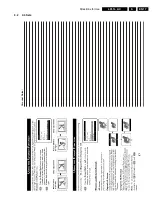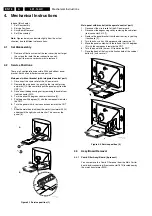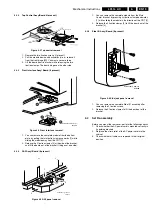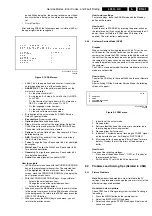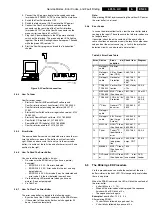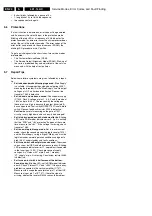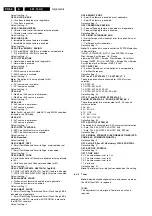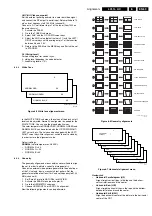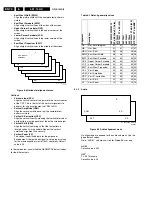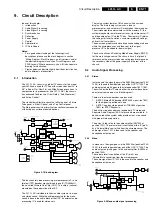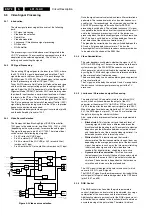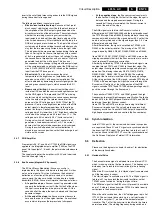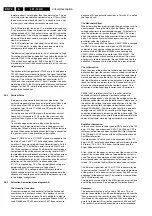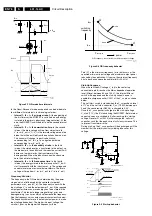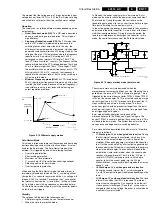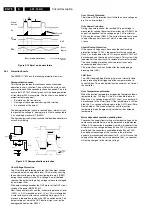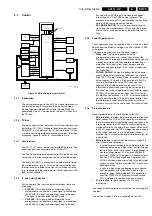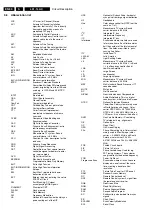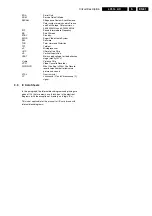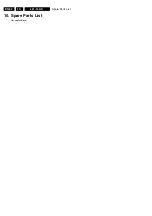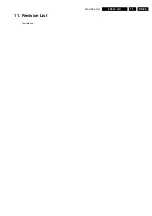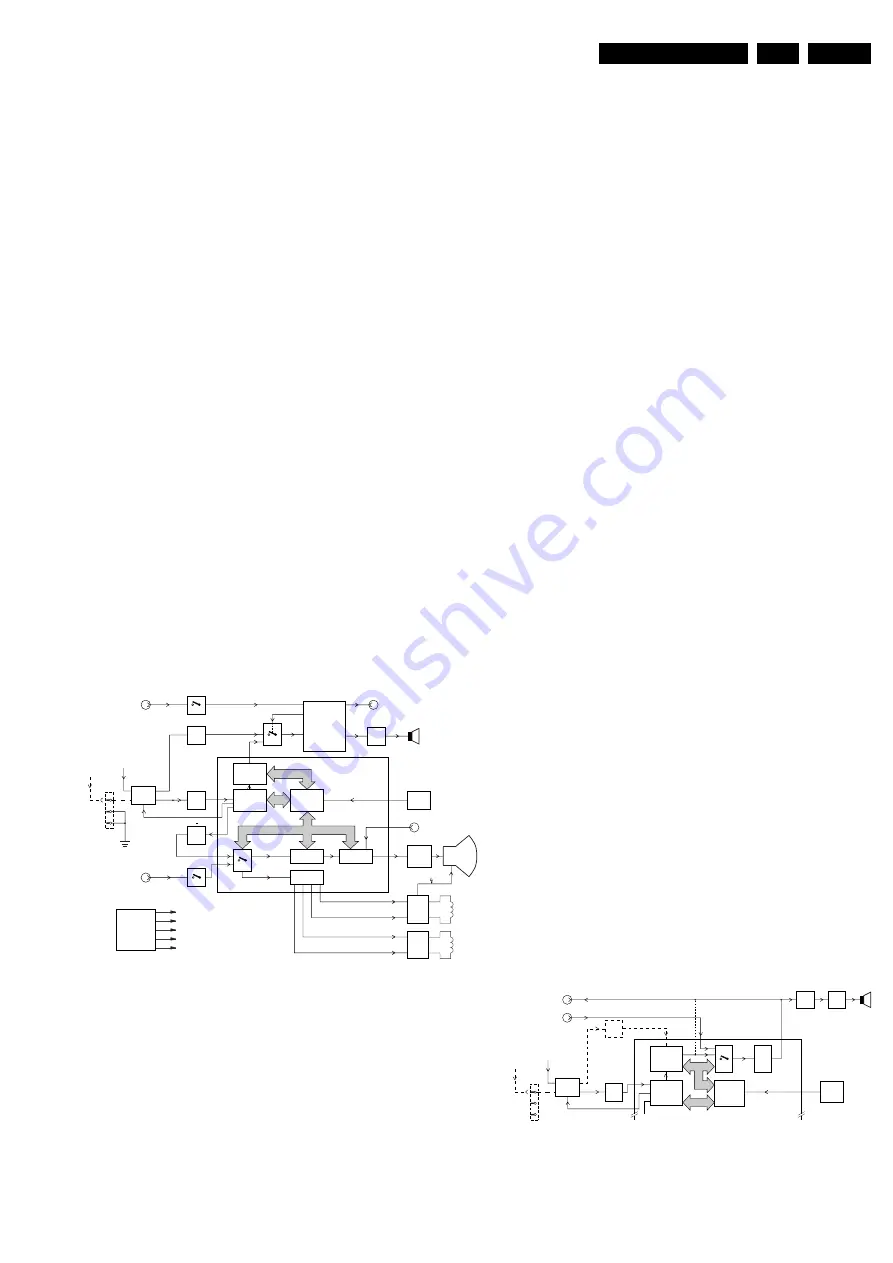
Circuit Description
9.
9.
Circuit Description
Index of this chapter:
1.
Introduction
2.
Audio Signal Processing
3.
Video Signal Processing
4.
Synchronization
5.
Deflection
6.
Power Supply
7.
Control
8.
Abbreviations
9.
IC Data Sheets
Notes:
•
For a good understanding of the following circuit
descriptions, please use the block diagram in section
'Wiring Diagram, Block Diagrams, and Overviews' and/or
the electrical diagrams in section 'Circuit Diagrams and
PWB Layouts'. Where necessary, you will find a separate
drawing for clarification.
•
Figures below can deviate slightly from the actual situation,
due to different set executions.
9.1
Introduction
The 'L01.1L AC' chassis is a global TV chassis for the model
year 2003 and is used for TV sets with screen sizes from 20" to
36", in Super Flat, Real Flat, and Wide Screen executions. In
comparison to its predecessor (the 'L01.1L AB'), the chassis
has enhanced features like 'Virtual Dolby', 'Sub Woofer out',
and 'Active Control'.
The standard architecture consists of a Main panel, a Picture
Tube panel, a Side I/O panel, and a Top Control panel.
The Main panel consists primarily of conventional components
with hardly any surface mounted devices.
Figure 9-1 Block diagram
The functions for video processing, microprocessor (uP), and
teletext (TXT) decoder are combined in one IC (TDA958xH),
the so-called Ultimate One Chip (UOC). This chip is (surface)
mounted on the copper side of the LSP.
The 'L01.1L AC' is divided into 2 basic audio systems, i.e. mono
and stereo sound. While the audio processing for the mono
sound is done in the audio block of the UOC, an external audio
processing IC is used for stereo sets.
The tuning system features 181 channels with on-screen
display. The main tuning system uses a tuner, a
microcomputer, and a memory IC mounted on the main panel.
The microcomputer communicates with the memory IC, the
customer keyboard, remote receiver, tuner, signal processor IC
and the audio output IC via the I
2
C bus. The memory IC retains
the settings for favorite stations, customer-preferred settings,
and service / factory data.
The on-screen graphics and closed caption decoding are done
within the microprocessor, and then sent to the signal
processor IC to be added to the main signal.
The chassis utilizes a Switching Mode Power Supply (SMPS)
for the main voltage source. The chassis has a 'hot' ground
reference on the primary side and a cold ground reference on
the secondary side of the power supply and the rest of the
chassis.
9.2
Audio Signal Processing
9.2.1
Stereo
In stereo sets, the signal goes via the SAW filter (position 1002/
1003), to the audio demodulator part of the UOC IC 7200. The
audio output on pin 33 goes to the stereo decoder 7831/ 7861.
The switch inside this IC selects either the internal decoder or
an external source (see also ‘block diagram’).
There are two stereo decoder versions used:
1.
A BTSC Stereo/SAP decoder (MSP34X5 at position 7831)
for the highest specified sets, and
2.
A BTSC non-dbx stereo decoder (TDA9853 at position
7861) for BTSC Economic.
The built-in stereo decoder can receive both TV stereo and
Separate Audio Program (SAP) telecasts where available. A
dbx noise reduction system helps provide clear, crisp sound
with proper stereo separation.
The output is fed to the to the audio amplifier (AN7522 at
position 7901). The volume level is controlled at this IC (pin 9)
by a 'Volume|Mute' control line from the microprocessor. The
audio signal from 7901 is then send to the speaker and
headphone output panel.
9.2.2
Mono
In mono sets, the signal goes via the SAW filter (position 1002/
1003), to the audio demodulator part of the UOC IC 7200. The
audio output on pin 48 goes to the audio amplifier (AN7523 at
position 7902).
The volume level is controlled at this IC (pin 9) by a
'Volume|Mute' control line from the microprocessor.
The audio signal from IC 7902 is then send to the speaker and
headphone output panel.
Figure 9-2 Mono audio signal processing
TUNER
VBAT
AUDIO
12V
3.9V
3.3V
FM IF
BUFFER
NOT FOR
NAFTA
VIDEO SOURCE
SELECTION
RF ANT.
FM ANT.
EXT. AUDIO
INPUT
7801
AUDIO SOURCE SELECTION
CONTROL
EXT. AUDIO OUT
7861
7831
7834
7835
7209
7210
7901
10
1000
0265
11
1
1
1
AGC
1200 : 1202
18
19
38
INT_CVBS
EXT_CVBS
40
42
16
17
15
30
68
I2C
50:53
EXT RGB/YUV INPUT
56:58
7330
EHT
7460
H
EW
V+
V-
7471
7602
7200
POWER
SUPPLY
CL 16532016_01a.eps
120303
AUDIO
AMPL.
SAW
FILTER
SOUND
IF
DEMOD.
AUDIO DECODING
AND
PROCESSING
SELECTION
MATR. SWITCH
VISION
IF
DEMOD.
NVM
VIDEO
AMPL.
HOR.
DEFL.
+
EW
VERT.
DEFL.
µ
P
VIDEO
PROCESSING
RGB/YUV
PROCESSING
SYNC
PROCESSING
SOUND
TRAP
VIDEO
SWITCH
EXT. VIDEO
INPUT
7802
TUNER
RF ANT.
EXT. AUDIO
OUTPUT
EXT. AUDIO
INPUT
7902
10
1000
11
1
1
1
AGC
18
19
68
7602
AUDIO SWITCH
7200
AVL
FM PRE
AMP.
NOT FOR
NAFTA
AUDIO
AMPL.
SMART
SND
SAW
FILTER
SOUND
IF
DEMOD.
VISION
IF
DEMOD.
NVM
µ
P
CL 16532016_01b.eps
120401
FM ANT.
0265
Summary of Contents for L01.1L AC
Page 6: ...Directions for Use EN 6 L01 1L AC 3 3 Directions for Use 3 1 16 9 Sets ...
Page 7: ...Directions for Use EN 7 L01 1L AC 3 ...
Page 8: ...Directions for Use EN 8 L01 1L AC 3 ...
Page 9: ...Directions for Use EN 9 L01 1L AC 3 ...
Page 10: ...Directions for Use EN 10 L01 1L AC 3 ...
Page 11: ...Directions for Use EN 11 L01 1L AC 3 ...
Page 12: ...Directions for Use EN 12 L01 1L AC 3 ...
Page 13: ...Directions for Use EN 13 L01 1L AC 3 ...
Page 14: ...Directions for Use EN 14 L01 1L AC 3 ...
Page 15: ...Directions for Use EN 15 L01 1L AC 3 ...
Page 16: ...Directions for Use EN 16 L01 1L AC 3 Personal Notes ...
Page 17: ...Directions for Use EN 17 L01 1L AC 3 3 2 4 3 Sets Personal Notes ...
Page 42: ...Spare Parts List EN 82 L01 1L AC 10 10 Spare Parts List Not applicable yet ...
Page 43: ...Revision List EN 83 L01 1L AC 11 11 Revision List First release ...

